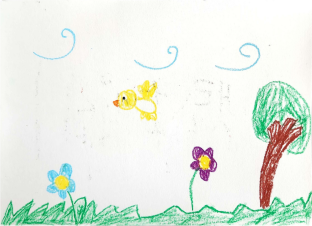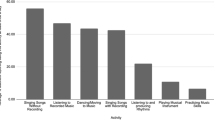Abstract
The aim of this study was to investigate the understanding and reactions of Korean young children to music through analysis of their drawings and the accompanying explanations they present while listening to a musical piece ‘The Elephant’ from ‘The Carnival of the Animals’ by Saint-Saëns. Drawings and explanations from 36 six-year-olds were analyzed, revealing three distinct categories: a) expression of emotions evoked by the music, b) representation of music focusing on musical elements such as tempo, dynamics, rhythm, and timbre, and c) depiction of musical changes through storytelling. These findings underscore young children’s capacity for diverse musical interpretations and responses, independent of prior knowledge, prompting reflection among early childhood educators on the purpose and delivery of music education for young children.









Similar content being viewed by others
References
Acker, A., Nyland, B., & Deans, J. (2011). Young children and music: Participatory learning and intentional teaching. Victorian Journal of Music Education, 1, 13–19.
Adachi, M., & Bradshaw, D. H. (1995). Children’s symbolic representations of rhythm patterns across tasks. In biennial meeting of the Society for Research in Child Development, Indianapolis, IN.
Barrett, M. S. (2004). Thinking about the representation of music: A case-study of invented notation. Bulletin of the Council for Research in Music Education, 161(162), 19–28.
Bingham, A. J. (2023). From data management to actionable findings: A five-phase process of qualitative data analysis. International Journal of Qualitative Methods, 22, 1–11. https://doi.org/10.1177/16094069231183620
Çetin, Z., & Güneş, N. (2021). Drawing as a means of self-expression: A case study. Early Child Development & Care, 191(1), 136–147. https://doi.org/10.1080/03004430.2019.1608195
Dockett, S., Einarsdottir, J., & Perry, B. (2011). Balancing methodologies and methods in researching with young children. In D. Harcourt, B. Perry, & T. Walker (Eds.), Researching young children’s perspectives: Debating the ethics and dilemmas of educational research with children (pp. 68–81). Routledge.
Einarsdottir, J., Dockett, S., & Perry, B. (2009). Making meaning: Children’s perspectives expressed through drawings. Early Child Development & Care, 179(2), 217–232. https://doi.org/10.1080/03004430802666999
Elkoshi, R. (2015). Children’s invented notations and verbal responses to a piano work by Claude Debussy. Music Education Research, 17(2), 179–200. https://doi.org/10.1080/14613808.2014.930116
Eum, K. L., & Kim, Y. Y. (2018). Analysis of the research trend of early childhood music listening education through the examination of theses published in Korea. Journal of Music Education Science, 37, 79–97. https://doi.org/10.30832/JMES.2018.37.79
Fortuna, S., & Nijs, L. (2020). Children’s verbal explanations of their visual representation of the music. International Journal of Music Education, 38(4), 563–581. https://doi.org/10.1177/0255761420932689
Gluschankof, C. (2018). Young children as music connoisseurs. Min-Ad: Israel Studies in Musicology Online, 15(2), 211–227.
Gordon, E. E. (2007). Learning sequences in music: A contemporary music learning theory (2007 ed.). GIA.
Gromko, J. E., & Poorman, A. S. (1998). Developmental trends and relationships in children’s aural perception and symbol use. Journal of Research in Music Education, 46(1), 16–23.
Hall, E. (2020). My rocket: Young children’s identity construction through drawing. International Journal of Education & the Arts, 21(28). https://doi.org/10.26209/ijea21n28
Han, Y. (2012). The integrated arts experience in music class [Unpublished master’s thesis]. The Pennsylvania State University.
Han, Y. (2016). Expanding music listening experience through drawing. General Music Today, 29(3), 12–18. https://doi.org/10.1177/1048371315622005
Havigerová, J. M., Pohnetalová, Y., Strnadová, K., Kocourková, K., & Podubecká, D. (2021). Preschool children’s drawings: Frequency and theme analysis. International Journal of Education and Literacy Studies, 9(3), 70–77. https://doi.org/10.7575/aiac.ijels.v.9n.3p.70
Hong, S. B., Broderick, J. T., & McAuliffe, C. M. (2021). Drawing to learn: A classroom case study. Early Childhood Education Journal, 49, 15–25. https://doi.org/10.1007/s10643-020-01041-9
Ilari, B. (2016). Music in the early years: Pathways into the social world. Research Studies in Music Education, 38(1), 23–39. https://doi.org/10.1177/1321103X16642631
Jang, Y. H., & Oh, Y. J. (2011). 유아의 음악 감상을 통한 통합적인 음악활동이 음악능력 및 음악적 창의력에 미치는 영향 [The effect of integrated music activities through young children’s music appreciation on musical abilities and musical creativity]. Korean Society for Early Childhood Physical Education, 12(1), 71-88
Kang, S. Y., & Kim, K. S. (2011). 음악개념 중심의 통합적 유아 음악감상과 표현활동이 유아의 음악개념 및 음악적 표현력에 미치는 영향 [The effects of the application of integrated music appreciation and expression activities based on young children’s music concepts and their ability to express music]. The Journal of Eco Early Childhood Education & Care, 10(3), 147-169
Kenney, S. (2008). Birth to six: Music behaviors and how to nurture them. General Music Today, 22(1), 32–34. https://doi.org/10.1177/1048371308323033
Kenny, S. H. (2013). Moving music, mapping music: Connecting children to the classes. General Music Today, 26(3), 44–47. https://doi.org/10.1177/1048371312474463
Kim, D. H., & Kim, H. S. (2024). 클래식 음악을 활용한 음악 감상활동이 유아의 음악적성에 미치는 효과 [The effects of music appreciation using classical music activities on musical aptitude of young children]. Journal of Learner-Centered Curriculum and Instruction, 24(1), 447–457. https://doi.org/10.22251/jlcci.2024.24.1.447
Kim, H. J. (2003). 5–6세를 위한 음악 감상 교육 지도안 연구: 생상의 ‘동물의 사육제’를 중심으로 [The study of the methodological appreciation for five and six years old-with priority given to the ‘Carnival of the animals’ of Saint-Saens] [Unpublished master’s thesis]. Dankook University.
Kim, J. (2018). 유아음악교육의 기초 [Foundation of early childhood music education]. Powerbook.
Kuperman, A., Aladjem, R., Dagan, O., & Mioduser, D. (2022). From 3D to 2D: Drawing as documentation and reflection processes by young children. Design and Technology Education: An International Journal, 27(2), 6–23.
Lee, S. K., & Choi, J. S. (2011). 포괄적 음악감상 활동이 유아의 창의적 미술표현력에 마치는 영향 [Influence of comprehensive music appreciation activity upon the creative art expression abilities of young children]. Art Education Review, 39, 125-149.
Marshall, C., & Rossman, G. B. (2015). Designing qualitative research (6th ed.). UK: SAGE.
Marton, F. (1986). Phenomenography: A research approach to investigating different understandings of reality. Journal of Thought, 21(3), 28–49. Retrieved March 15, 2023 from http://www.jstor.org/stable/42589189
Matthews, J. (2003). Drawing and painting: Children and visual representations. Paul Chapman.
Nam, S. O., & Kim, H. (2013). 통합적 음악 감상 활동이 유아의 음악개념 및 음악창의성에 미치는 효과 [The effects of integrated music appreciation activities on the musical concepts and creativity of young children]. The Journal of Korea Open Association for Early Childhood Education, 18(5), 241-263.
Oh, J. H. (2010). 어린이들의 그림에 나타난 표제음악의 음악적 이미지 분석 연구 [Children’s symbolic expression of musical image evoked by program music]. Korean Journal of Arts Education, 8(1), 21-40.
Orgill, M. (2012). Phenomenography. In N. M. Seel (Ed.), Encyclopedia of the Sciences of Learning. Springer. https://doi.org/10.1007/978-1-4419-1428-6_271
Oxford Dictionary of English (n.d.). Music. Oxford University Press.
Rajan, R. S. (2013). I’ve got rhythm! Fostering child-centered musical activities for preschoolers. General Music Today, 26(2), 9–13. https://doi.org/10.1177/1048371312447937
Roels, J. M., & van Petegem, P. (2014). The integration of visual expression in music education for children. British Journal of Music Education, 31(3), 297–317. https://doi.org/10.1017/S0265051714000163
Song, J. (2007). 생상의 <동물의 사육제> 분석 및 감상지도안 연구 [An analysis of Le Carnival des Animaux by Saint-Saens and a teaching plan for music appreciation class] [Unpublished master’s thesis]. Ewha Womans University.
Southcott, J., & Cosaitis, W. (2015). Drawing ‘music and me’: Children’s images of musical engagement. Australian Journal of Music Education, 2, 78–90.
Svensson, L. (2024). The historical methodological foundation of phenomenography. Qualitative Inquiry. Advance online publication. https://doi.org/10.1177/10778004241227270
Swingley, D. (2022). Infants’ learning of speech sounds and word-forms. In A. Papafragou, J. C. Trueswell, & L. R. Gleitman (Eds.), Oxford handbook of the mental lexicon (pp. 267–291). Oxford University Press.
Todd, J. R., & Mishra, J. (2013). Making listening instruction meaningful: A literature review. Update: Applications of Research in Music Education, 31(2), 4–10. https://doi.org/10.1177/8755123312473609
Tolfree, E., & Hallam, S. (2016). Children and young people’s uses of and responses to music in their everyday lives: A pilot study. The Psychology of Education Review, 40(2), 44–50.
Webster, P., & Richardson, C. (1994). Asking children to think about music. Research Studies in Music Education, 2(1), 8–14.
Young, S. (2016). Early childhood music education research: An overview. Research Studies in Music Education, 38(1), 9–21. https://doi.org/10.1177/1321103X16640106
Author information
Authors and Affiliations
Corresponding author
Additional information
Publisher's Note
Springer Nature remains neutral with regard to jurisdictional claims in published maps and institutional affiliations.
Rights and permissions
Springer Nature or its licensor (e.g. a society or other partner) holds exclusive rights to this article under a publishing agreement with the author(s) or other rightsholder(s); author self-archiving of the accepted manuscript version of this article is solely governed by the terms of such publishing agreement and applicable law.
About this article
Cite this article
Chang, JY., Kim, J. & Lee, S.Y. When Saint-Saëns’ Elephant Becomes a Child’s Raindrops: Korean Young Children’s Appreciation of Music through Drawings. Early Childhood Educ J (2024). https://doi.org/10.1007/s10643-024-01672-2
Accepted:
Published:
DOI: https://doi.org/10.1007/s10643-024-01672-2




